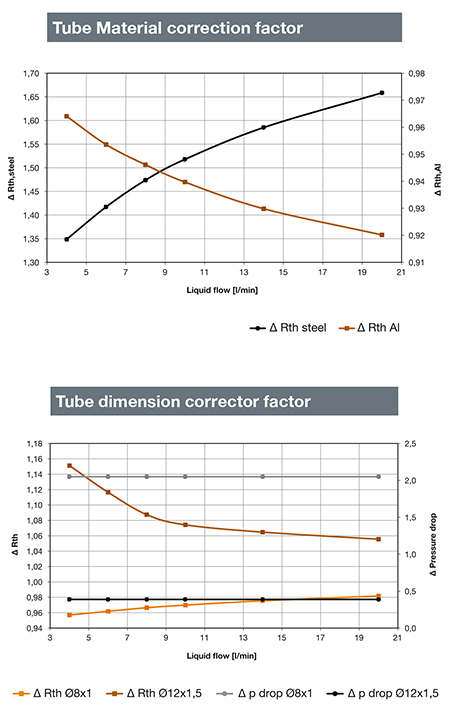TECHNICAL INFORMATION
 Material and mechanical processing
Material and mechanical processing
The lightness (2.7 g/cm3), thermal conductivity (120-229 W/m• K) and high workability are the features that make aluminum the main material used for the construction of our LCPs.
Depending on the technology for the design of the liquid-cooled plate, the possible types of material usable for the base plate are:
• EN AW-1050A aluminium alloy
• EN AW-5083 aluminium alloy
• EN AW-6060 aluminium alloy
• EN AW-6082 aluminium alloy
• EN AW-6101B aluminium alloy
• EN AW-42100 aluminium alloy
• HCP CW021A copper alloy
In addition to the most common extruded solution, the raw material is available in hot rolled casting slabs. Maximum flexibility in size and the absence of additional costs for the construction of dedicated dies.
Unless otherwise specified in the drawing, the products are mechanically processed in compliance with general tolerances specified by ISO 2768-mK.
How to choose a liquid cooled plate
Liquid-cooling is the most effective way to dissipate the heat generated by electronic components, offering performance not achievable with air-cooling and at the same time limiting the overall dimensions. As it is for an air cooled heat sink, the thermal performance of a LCP is measured using thermal resistance RTH [K/W] which describes how much warmer the surface becomes (TMAX) in relation to the coolant temperature (TIN), which flows inside for a given thermal load represented by the power dissipated by the electronic devices to be cooled (Pd).

It is therefore necessary to design and identify a LCP with a thermal resistance equal to or lower than the calculated one.
The thermal performance of a LCP depends on the coolant flow that goes through it. To increase its performance, Mecc.Al offers the option to assemble special accessories - turbulators or offset fins layers - capable of increasing the fluid turbulence for greater efficiency in heat dissipation.
In the technology selection for the construction of a LCP, particular attention should be paid to the type and quality of the coolant used to prevent corrosion. If the aggressiveness of the coolant increases, it is necessary to switch from aluminum channels to copper or stainless steel ones.
Equally important for the design of a liquid-cooled plate is the identification of the maximum allowable pressure drop value, identified by the liquid cooling system at the outlet of the LCP.
If the value of the liquid flow that goes through the LCP increases, the thermal resistance value decreases, while the pressure drop value increases.
Thermal resistance and pressure drop measurement conditions
The catalog shows the graphs of the thermal resistance and pressure drop values while the coolant flow is varying. Graphs referring to some of the many possible configurations of the different manufacturing technologies. Each LCP is designed and manufactured according to the design specifications to obtain an optimized product right from the prototyping stage. The Technical and Design Department of Mecc.Al makes use of modern computing systems such as CFD (Computational Fluid Dynamics) - SolidWorks Flow Simulation - which for different cooling channel configurations allow to check the reliability of the design specifications in terms of thermal resistance and pressure drop.
The values shown in the graphs come from thermal simulations and laboratory tests according to the assembly layout shown in the drawing and considering the maximum point value of temperature reached on the surface of the LCP. The coolant used is water with no additive at an inlet temperature of 40°C and at a pressure of 202,650 Pa.
In Embedded Tube technology, the tube coils of the tested LCPs are made of copper, with a diameter of 10mm and wall thickness of 1.5 mm. For different tube materials and sizes please refer to the “Tube Material Correction Factor” and “Tube Dimension Correction Factor” graphs to determine the multiplication factor to apply to the thermal resistance and pressure drop values shown.
The design flexibility of the Mecc.Al liquid-cooled technologies offers various possibilities for the positioning of the coolant inlet and outlet terminals. In addition there are various types of connectors that can be assembled.
Standard connectors:
• Welded brass fittings with male/female GAS threaded or hose adapter
• Stainless steel or brass push-on connectors with ogiva
Customized connectors:
• Welded copper/brass turning fittings
• Copper connector blocks welded to the ends of the tube coil and mechanically assembled to the base plate
• Brazed or mechanically assembled aluminum fittings or blocks
Surface treatments:
Anodizing, passivation and nickel plating, applicable depending on the construction technology used. They have a negligible effect on the thermal performance of a LCP but are mainly used to improve the surface corrosion resistance.
Every single LCP produced by Mecc.Al is subjected to leakage tests and it is traceable by an univocal progressive numbering. The pressure drop test instead is performed on specific request and in the prototyping stage.
The technical data shown in the catalog, originating from laboratory tests and thermal simulations are reliable. However, because real conditions of use may be different from those in the laboratory, it is advisable to check them through an empirical test in LCP real use conditions.